Ovulation in a typical, or "average," cycle usually occurs on day __________.
- 14
- 21
- 1
- 28
- 5
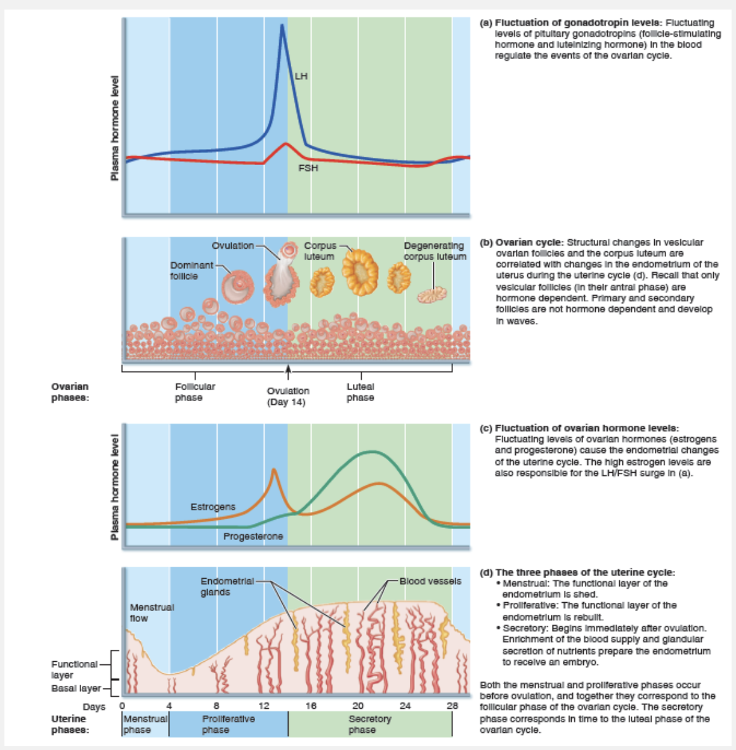
14
Ex.
Ovulation in a typical, or "average," cycle usually occurs on day 14.
LH surge triggers ovulation and formation of the corpus luteum. The high estrogen level sets a cascade of events into motion. There is a sudden burstlike release of accumulated LH (and, to a lesser extent, FSH) by the anterior pituitary about midcycle.
The LH surge rouses the primary oocyte of the dominant follicle from its resting state and it completes its first meiotic division, forming a secondary oocyte that continues on to metaphase II. Around day 14, LH—aided by intraovarian paracrines—stimulates many events that lead to ovulation: It increases local vascular permeability and triggers an inflammatory response that promotes release of metalloproteinase enzymes that weaken the ovary wall. As a result, blood stops flowing through the protruding part of the follicle wall. Within minutes, that region of the follicle wall thins, bulges, and ruptures, forming a hole. The oocyte, still surrounded by its corona radiata, exits, accomplishing ovulation.
Shortly after ovulation, estrogen levels decline. This probably reflects the damage to the dominant estrogen-secreting follicle during ovulation.
The LH surge also transforms the ruptured follicle into a corpus luteum (which gives LH its name, “luteinizing” hormone). LH stimulates this newly formed endocrine structure to produce large amounts of progesterone and some estrogens almost immediately after it is formed. Progesterone helps maintain the stratum functionalis and is essential for maintaining pregnancy should conception occur.
Within the ovary, progesterone is produced by the __________.
- secondary follicles
- primary follicles
- corpus luteum
- tertiary follicles
- corpus albicans

corpus luteum
Ex.
Within the ovary, progesterone is produced by the corpus luteum.
LH surge triggers ovulation and formation of the corpus luteum. The high estrogen level sets a cascade of events into motion. There is a sudden burstlike release of accumulated LH (and, to a lesser extent, FSH) by the anterior pituitary about midcycle.
The LH surge rouses the primary oocyte of the dominant follicle from its resting state and it completes its first meiotic division, forming a secondary oocyte that continues on to metaphase II. Around day 14, LH—aided by intraovarian paracrines—stimulates many events that lead to ovulation: It increases local vascular permeability and triggers an inflammatory response that promotes release of metalloproteinase enzymes that weaken the ovary wall. As a result, blood stops flowing through the protruding part of the follicle wall. Within minutes, that region of the follicle wall thins, bulges, and ruptures, forming a hole. The oocyte, still surrounded by its corona radiata, exits, accomplishing ovulation.
Shortly after ovulation, estrogen levels decline. This probably reflects the damage to the dominant estrogen-secreting follicle during ovulation.
The LH surge also transforms the ruptured follicle into a corpus luteum (which gives LH its name, “luteinizing” hormone). LH stimulates this newly formed endocrine structure to produce large amounts of progesterone and some estrogens almost immediately after it is formed. Progesterone helps maintain the stratum functionalis and is essential for maintaining pregnancy should conception occur.
Correctly match the following: Progesterone.
- Causes a growth spurt at puberty
- Causes ovulation
- Promotes the secretory phase of the uterine cycle
- Responsible for the sex drive in females

Promotes the secretory phase of the uterine cycle
Ex.
Progesterone promotes the secretory phase of the uterine cycle.
This 14-day phase is the most constant timewise. During the secretory
phase the endometrium prepares for an embryo to implant. Rising levels of progesterone from the corpus luteum act on the estrogen-primed endometrium, causing the spiral arteries to elaborate and converting the functional layer to a secretory mucosa. The endometrial glands enlarge, coil, and begin secreting nutrients into the uterine cavity that will sustain the embryo until it has implanted in the blood-rich endometrial lining.
As progesterone levels rise, the cervical mucus becomes viscous again, forming the cervical plug, which helps to block entry of sperm and pathogens or other foreign materials. Progesterone also plays an important role in keeping the uterus “private” in the event an embryo has begun to implant. Rising progesterone (and estrogen) levels inhibit LH release by the anterior pituitary.
During the ovarian cycle, FSH exerts its main effects on the granulosa cells of vesicular follicles, causing them to release __________.
- progesterone
- estrogens
- LH
- GnRH
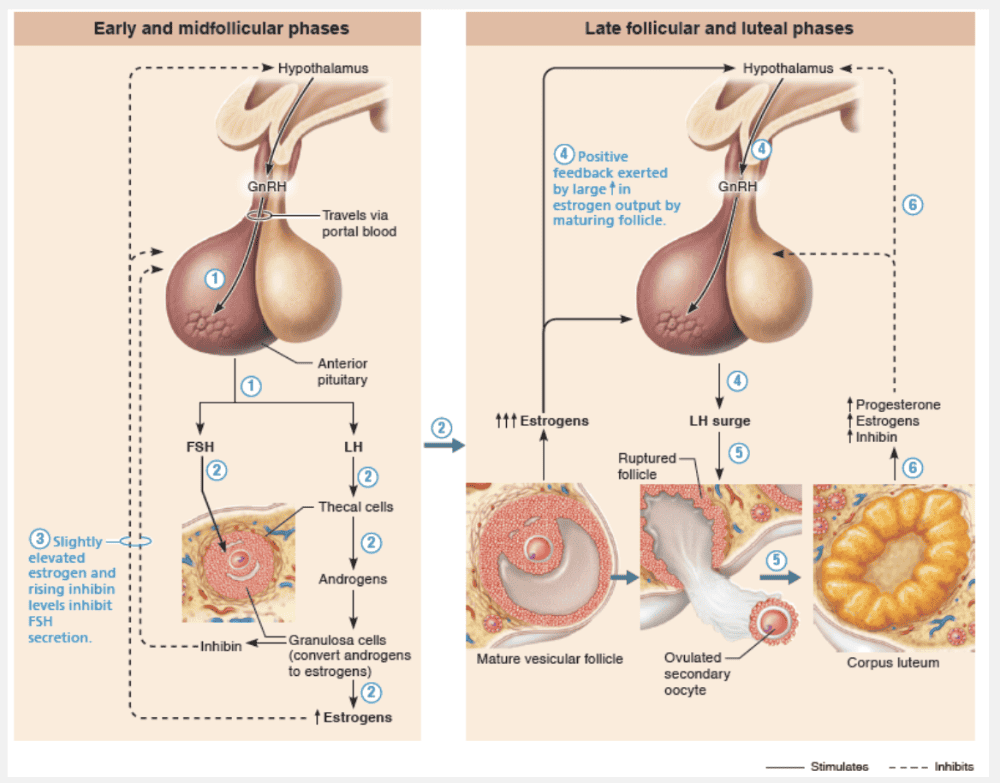
estrogens
Ex.
During the ovarian cycle, FSH exerts its main effects on the granulosa cells of vesicular follicles, causing them to release estrogens.
In females, levels of anterior pituitary gonadotropins (FSH and LH) andovarian hormones wax and wane, and there is both negative and positive feedback during each cycle. 1. GnRH stimulates FSH and LH secretion.2. FSH and LH stimulate follicles to grow, mature, and secrete sex hormones. FSH exerts its main effects on thegranulosa cells of vesicular follicles, causing them torelease estrogens, whereas LH (at least initially) prods the thecal cells to release androgens, which the granulosa cellsconvert to estrogens. Only tiny amounts of ovarian androgensenter the blood, because they are almost completely converted to estrogens within the ovaries.
What is the most common bacterial sexually transmitted disease in the U.S.?
- Syphilis
- Gonorrhea
- Genital warts
- Chlamydia
Chlamydia
Ex.
Chlamydia is the most common bacterial sexually transmitted disease in the U.S.
Chlamydia (klah-mid′e-ah; chlamys = cloak) is a largely undiagnosed, silent epidemic that is currently on the rise in college-age people. It infects perhaps 4–5 million people yearly (more than 1 million in the United States), making it the most common bacterial sexually transmitted infection in the country.
Chlamydia is responsible for 25–50% of all diagnosed cases of pelvic inflammatory disease, and each year more than 150,000 infants are born to infected mothers.
Chlamydia trachomatis is a bacterium with a virus-like dependence on host cells. Its incubation period within the body cells is about one week. Symptoms include urethritis (involving painful, frequent urination and a thick penile discharge); vaginal discharge; abdominal, rectal, or testicular pain; painful intercourse; and irregular menses. In men, it can cause arthritis as well as widespread urogenital tract infection. In women, 80% of whom suffer no symptoms from the infection, it is a major cause of sterility. Newborns infected in the birth canal tend to develop conjunctivitis, a painful eye infection that leads to corneal scarring if untreated, and respiratory tract inflammations including pneumonia. Chlamydia can be diagnosed by cell culture techniques and is easily treated with tetracycline.
Match the reproductive hormone with the correct characteristic: GnRH.
- Stimulates oogenesis directly on follicle cells
- Produced by interstitial endocrine cells
- Directly stimulates interstitial endocrine cells in males
- Produced during the second half of ovarian cycle
- Produced in the hypothalamus

Produced in the hypothalamus
Ex.
GnRH, gonadotropin releasing hormone, is produced in the hypothalamus.
GnRH stimulates FSH and LH secretion. GnRH secreted by the hypothalamus stimulates the anterior pituitary to produce and release follicle-stimulating hormone (FSH) and luteinizing hormone (LH).
The uterine layer shed with each monthly cycle is the __________.
- tunica albuginea
- myometrium
- functional layer of endometrium
- basal layer of endometrium
- perimetrium

functional layer of endometrium
Ex.
The uterine layer shed with each monthly cycle is the functional layer of endometrium.
In this phase, menstruation (men″stroo-a′shun) or menses, the uterus sheds all but the deepest part of its endometrium. The thick, hormone-dependent functional layer of the endometrium detaches from the uterine wall, a process accompanied by bleeding for 3–5 days. The detached tissue and blood pass out through the vagina as the menstrual flow. By day 5, the growing ovarian follicles start to produce more estrogens
Correctly match the following: Menarche.
- All cycles are ovulatory
- All cycles become regular
- Ovulation and menses cease
- First menstrual period
- Painful menstruation
First menstrual period
Ex.
Menarche is the term for the first menstrual period .
During childhood, the ovaries grow and continuously secrete small amounts of estrogens, which inhibit hypothalamic release of GnRH. Provided that leptin levels are adequate, the hypothalamus becomes less sensitive to estrogens as puberty nears and begins to release GnRH in a rhythmic pulselike manner. GnRH, in turn, stimulates the anterior pituitary to release FSH and LH, which prompt the ovaries to secrete hormones (primarily estrogens).
Gonadotropin levels continue to increase for about four years. During this time, pubertal girls are still not ovulating and cannot become pregnant. Eventually, the adult cyclic pattern is achieved, and hormonal interactions stabilize. These events are heralded by the young woman’s first menstrual period, referred to as menarche (mĕ-nar′ke; men = month, arche = first). Usually, it is not until the third year postmenarche that the cycles become regular and all are ovulatory.
Which hormone is produced by the developing follicles and corpus luteum?
- Estrogens
- Progesterone
- LH
- FSH
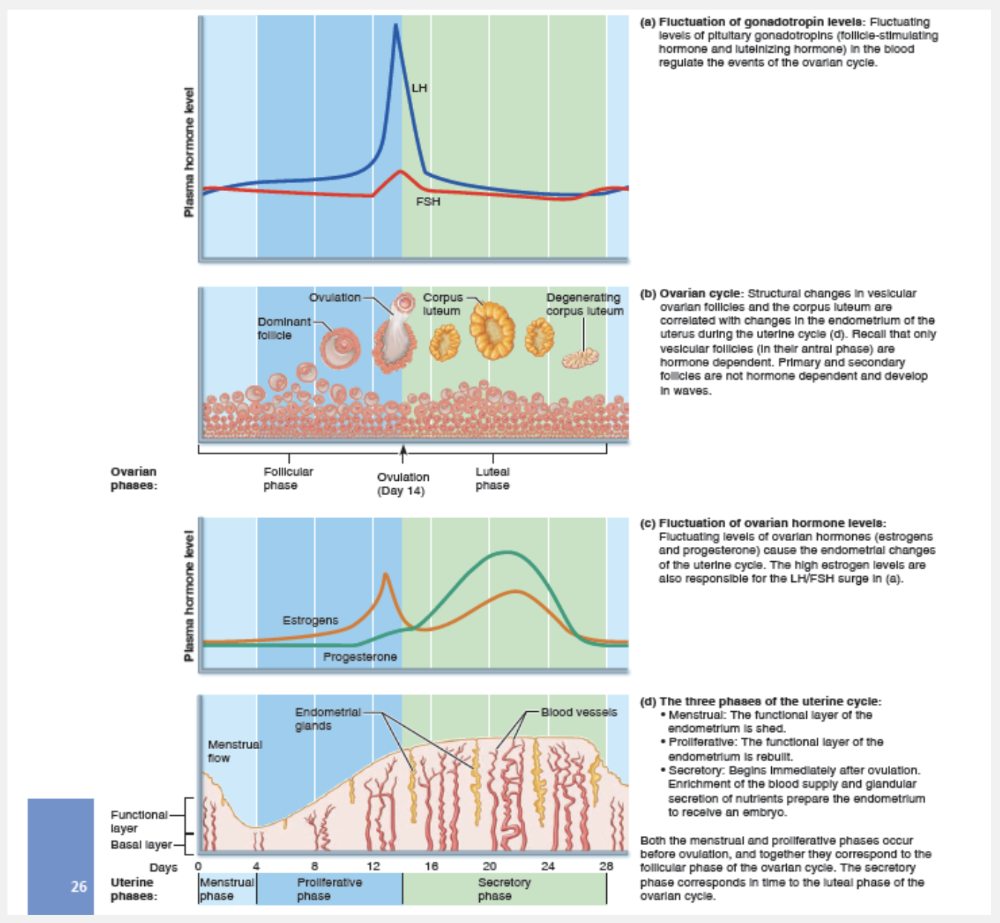
Estrogens
Ex.
The developing follicles and corpus luteum produce estrogens.
Progesterone is mainly produced by the corpus luteum. FSH and LH are produced by the anterior pituitary.
Which of the following is not an effect of estrogen?
- Promotes diuresis (water loss)
- Promotes the development of secondary sex characteristics in females
- Promotes oogenesis
- Helps to sustain the density of the skeleton
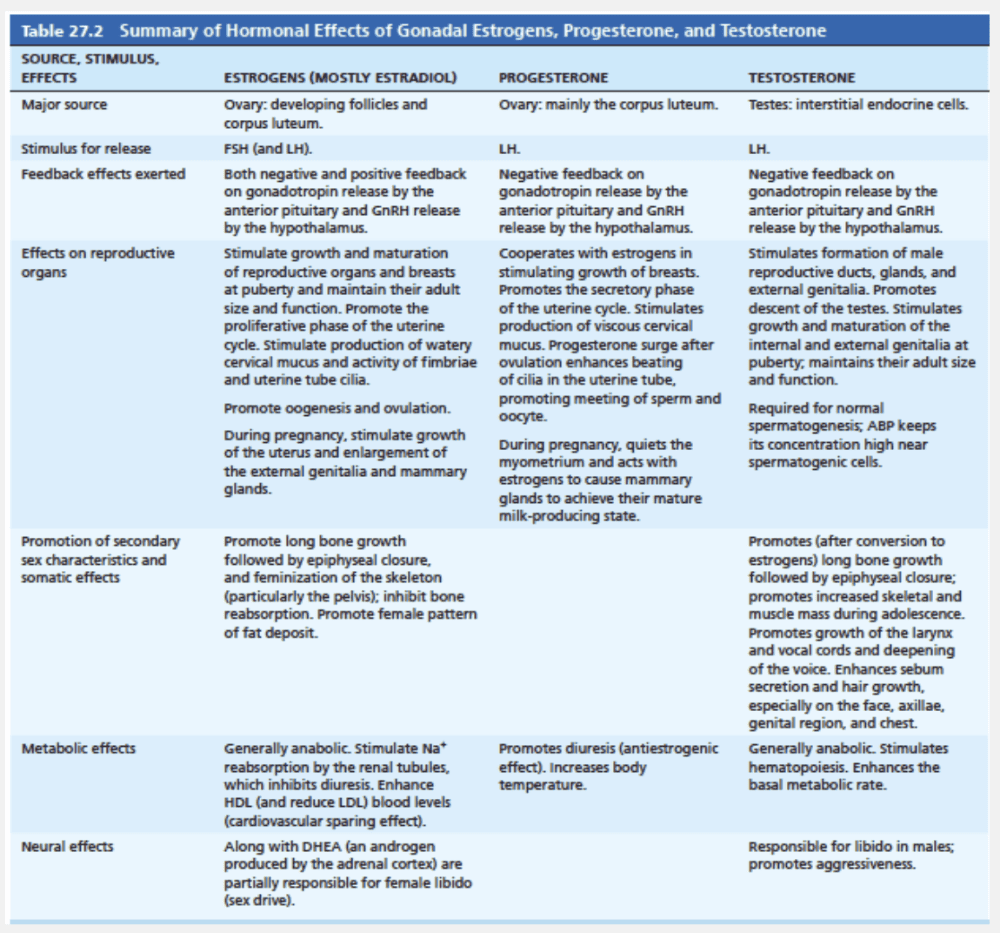
Promotes diuresis (water loss)
Ex.
Estrogen does not promote diuresis (water loss).
With a name meaning “generators of sexual activity,” estrogens are analogous to testosterone, the male steroid. As estrogen levels rise during puberty, they (1) promote oogenesis and follicle growth in the ovary and (2) exert anabolic effects on the female reproductive tract. Consequently, the uterine tubes, uterus, and vagina enlarge and become functional— more ready to support a pregnancy. The uterine tubes and uterus exhibit enhanced motility; the vaginal mucosa thickens; and the external genitalia mature.
The estrogen-induced secondary sex characteristics of females include:
- Breast development
- Increasing deposition of subcutaneous fat, especially in the hips and breasts
- Development of a wider and lighter pelvis (adaptations for childbirth)
Estrogens also have several metabolic effects, including maintaining low total blood cholesterol levels (and high HDL levels) and facilitating calcium uptake, which helps sustain the density of the skeleton. These metabolic effects begin under estrogens’ influence during puberty, but they are not true secondary sex characteristics.
Correctly match the hormone with the gland or cell that secretes it: LH.
- Interstitial endocrine cells
- Corpus luteum
- Follicular cells
- Anterior pituitary

Anterior pituitary
Ex.
The gland that secretes LH is the anterior pituitary.
During childhood, the ovaries grow and continuously secrete small amounts of estrogens, which inhibit hypothalamic release of GnRH. Provided that leptin levels are adequate, the hypothalamus becomes less sensitive to estrogens as puberty nears and begins to release GnRH in a rhythmic pulselike manner. GnRH, in turn, stimulates the anterior pituitary to release FSH and LH, which prompt the ovaries to secrete hormones (primarily estrogens).
What hormone is responsible for the secondary sex characteristics found in women?
- Progesterone
- Prolactin
- LH
- FSH
- Estrogen

Estrogen
Ex.
Estrogen is responsible for the secondary sex characteristics found in women.
With a name meaning “generators of sexual activity,” estrogens are analogous to testosterone, the male steroid. As estrogen levels rise during puberty, they (1) promote oogenesis and follicle growth in the ovary and (2) exert anabolic effects on the female reproductive tract. Consequently, the uterine tubes, uterus, and vagina enlarge and become functional— more ready to support a pregnancy. The uterine tubes and uterus exhibit enhanced motility; the vaginal mucosa thickens; and the external genitalia mature.
The estrogen-induced secondary sex characteristics of females include:
- Breast development
- Increasing deposition of subcutaneous fat, especially in the hips and breasts
- Development of a wider and lighter pelvis (adaptations for childbirth)
Estrogens also have several metabolic effects, including maintaining low total blood cholesterol levels (and high HDL levels) and facilitating calcium uptake, which helps sustain the density of the skeleton. These metabolic effects begin under estrogens’ influence during puberty, but they are not true secondary sex characteristics.
__________ acts upon the __________ to encourage the release of follicle-stimulating hormone (FSH) and luteinizing hormone (LH).
- Gonadotropin-releasing hormone; ovaries
- Gonadotropin-releasing hormone (GnRH); anterior pituitary
- Estrogen; ovaries
- Inhibin; anterior pituitary

Gonadotropin-releasing hormone (GnRH); anterior pituitary
Ex.
Gonadotropin-releasing hormone (GnRH) acts upon the anterior pituitary to encourage the release of follicle-stimulating hormone (FSH) and luteinizing hormone (LH).
The __________ is shed during menstruation.
- stratum basalis
- stratum functionalis
- perimetrium
- myometrium
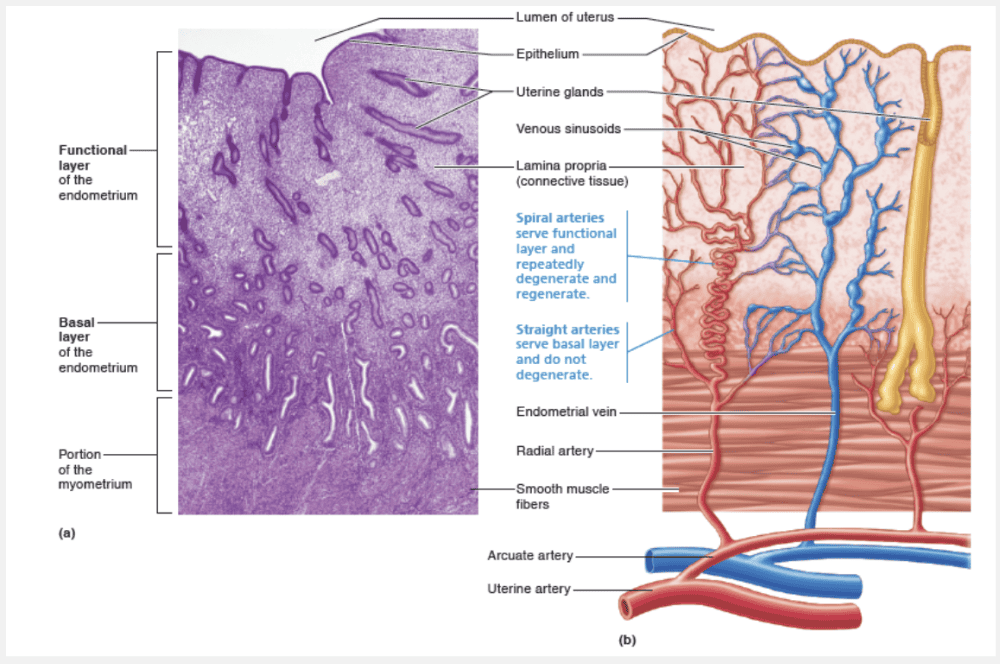
stratum functionalis
Ex.
The stratum functionalis is shed during menstruation.
The endometrium has two chief strata (layers). The stratum functionalis (fungk-shun-a′lis), or functional layer, undergoes cyclic changes in response to blood levels of ovarian hormones and is shed during menstruation (approximately every 28 days). Stem cells found in the thinner, deeper stratum basalis (ba-să′lis), or basal layer, form a new functionalis after menstruation ends. The endometrium has numerous uterine glands that change in length as endometrial thickness changes during the menstrual cycle.
Female libido seems to be driven by both ___________ and DHEA (an androgen produced by the adrenal cortex).
- LH
- progesterone
- estrogens
- testosterone

estrogens
Ex.
Female libido seems to be driven by both estrogens and DHEA (an androgen produced by the adrenal cortex). Progesterone and LH do not affect female libido. Testosterone is responsible for libido in males.
Match the reproductive hormone with the correct characteristic: FSH.
- Directly stimulates interstitial endocrine cells in males
- Stimulates granulosa cells to release estrogens
- Produced during the second half of ovarian cycle
- Produced by interstitial endocrine cells
- Produced in the hypothalamus

Stimulates granulosa cells to release estrogens
Ex.
FSH stimulates granulosa cells to release estrogens.
FSH and LH stimulate follicles to grow, mature, and secrete sex hormones. FSH exerts its main effects on the granulosa cells of vesicular follicles, causing them to release estrogens, whereas LH (at least initially) prods the thecal cells to release androgens which the granulosa cells convert to estrogens. Only tiny amounts of ovarian androgens enter the blood, because they are almost completely converted to estrogens within the ovaries.
Correctly match the following: Menopause.
- Ovulation and menses cease
- Production of testosterone
- Production of estrogen
- First menstrual period
- Responsible for stopping delivery of nutrients to spermatocytes
Ovulation and menses cease
Ex.
Menopause is the term for when ovulation and menses cease.
Most women reach the peak of their reproductive abilities in their late 20s. After that, ovarian function declines gradually, presumably because the ovaries become less and less responsive to gonadotropin signals. At age 30, there are still some 100,000 oocytes in the ovaries but the quality (hence fertility) has begun to decline. By age 50, there are probably 1000 eggs left (the pantry is nearly bare).
As estrogen production declines, many ovarian cycles become anovulatory, while in others 2 to 4 oocytes per month are ovulated. This sign of declining control explains why twins and triplets are more common in older women. In the perimenopausal period, menstrual periods become erratic and increasingly shorter. Eventually, ovulation and menstruation cease entirely. This normally occurs between the ages of 46 and 54, an event called menopause. Menopause is considered to have occurred when a whole year has passed without menstruation.
Select the layer of the uterus that is shed during menstruation.
- Basal layer of endometrium
- Perimetrium
- Myometrium
- Functional layer of endometrium
- Produces FSH
- Produces estrogen and progesterone

Functional layer of endometrium
Ex.
The functional layer of the endometrium is shed during menstruation.
The wall of the uterus is composed of three layers. The perimetrium is the incomplete outermost serous layer. The myometrium (“muscle of the uterus”)is the bulky middle layer, composed of interlacing bundles of smooth muscle. The myometrium contracts rhythmically during childbirth to expel the baby from the mother’s body. The endometrium is the mucosa that lines the uterine cavity. The endometrium has two chief layers. The functionallayer, or stratum functionalis, undergoescyclic changes in response to blood levels of ovarian hormonesand is shed during menstruation (about every 28 days). Stem cells found in the thinner, deeper basal layer, or stratum basalis, form a new functional layerafter menstruation ends.
Which cell type is actually ovulated from the ovary?
- Secondary oocyte
- Ovum
- Primary oocyte
- Oogonium
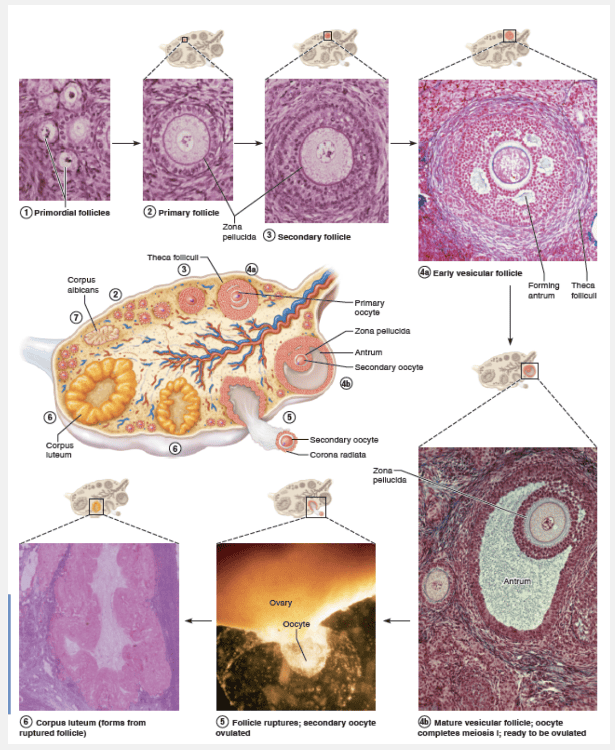
Secondary oocyte
Ex.
The secondary oocyte is the cell type actually ovulated from the ovary.
A secondary follicle becomes a vesicular (antral) follicle. The secondary follicle stage ends when a clear liquid begins to accumulate between the granulosa cells, producing the early vesicular (antral) follicle. When six to seven layers of granulosa cells are present, the fluid between the granulosa cells coalesces to form a large fluid-filled cavity called the antrum (“cave”). The presence of the antrum distinguishes vesicular follicles from all prior follicles (preantral follicles).
Correctly match the following: Myometrium.
- Visceral peritoneum over uterus
- Smooth muscle of the uterus
- Narrow neck or outlet of uterus
- Incomplete partition covering the vaginal orifice
- Mucosal lining of uterine cavity
- Rounded region anterior to the entrance of uterine tubes
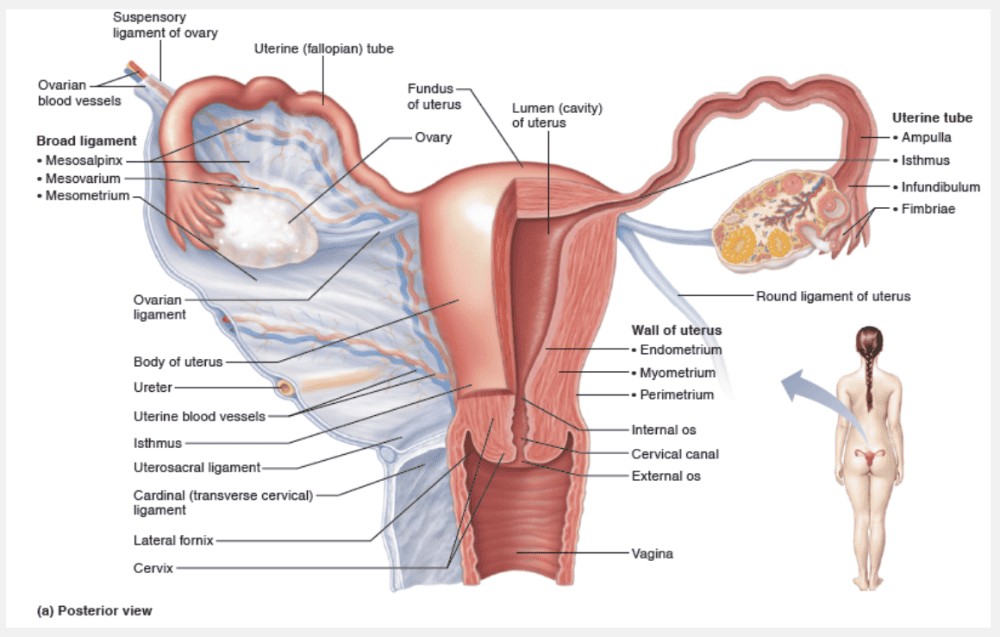
Smooth muscle of the uterus
Ex.
The myometrium is the smooth muscle of the uterus.
The wall of the uterus is composed of three layers (the figure above)
- Perimetrium, the incomplete outermost serous layer.
- Myometrium (mi″o-me′tre-um; “muscle of the uterus”), the bulky middle layer, composed of interlacing bundles of smooth muscle. The myometrium contracts rhythmically during childbirth to expel the baby from the mother’s body.
- Endometrium, the mucosal lining of the uterine cavity (the figure below). It is a simple columnar epithelium underlain by a thick lamina propria. If fertilization occurs, the young embryo burrows into the endometrium (implants) and resides there for the rest of its development.
Correctly match the following: Endometrium.
- Rounded region anterior to the entrance of uterine tubes
- Narrow neck or outlet of uterus
- Mucosal lining of uterine cavity
- Incomplete partition covering the vaginal orifice
- Visceral peritoneum over uterus
- Smooth muscle of uterus

Mucosal lining of uterine cavity
Ex.
The mucosal lining of uterine cavity is the endometrium.
The wall of the uterus is composed of three layers (the figure above):
- Perimetrium, the incomplete outermost serous layer.
- Myometrium (mi″o-me′tre-um; “muscle of the uterus”), the bulky middle layer, composed of interlacing bundles of smooth muscle. The myometrium contracts rhythmically during childbirth to expel the baby from the mother’s body.
- Endometrium, the mucosal lining of the uterine cavity (figure below). It is a simple columnar epithelium underlain by a thick lamina propria. If fertilization occurs, the young embryo burrows into the endometrium (implants) and resides there for the rest of its development.
__________ stimulates the anterior pituitary to release follicle-stimulating hormone (FSH) and luteinizing hormone (LH).
- Gonadotropin-releasing hormone
- Progesterone
- Estrogen
- Inhibin
Gonadotropin-releasing hormone
Ex.
Gonadotropin-releasing hormone (GnRH) stimulates the anterior pituitary to release follicle-stimulating hormone (FSH) and luteinizing hormone (LH).
During childhood, the ovaries grow and continuously secrete small amounts of estrogens, which inhibit hypothalamic release of GnRH. Provided that leptin levels are adequate, the hypothalamus becomes less sensitive to estrogens as puberty nears and begins to release GnRH in a rhythmic pulselike manner. GnRH, in turn, stimulates the anterior pituitary to release FSH and LH, which prompt the ovaries to secrete hormones (primarily estrogens).
Gonadotropin levels continue to increase for about four years. During this time, pubertal girls are still not ovulating and cannot become pregnant. Eventually, the adult cyclic pattern is achieved, and hormonal interactions stabilize. These events are heralded by the young woman’s first menstrual period, referred to as menarche (mĕ-nar′ke; men = month, arche = first). Usually, it is not until the third year postmenarche that the cycles become regular and all are ovulatory.
Which of the following is false regarding the female sexual response?
- Female orgasm is not required for conception.
- Testosterone is the hormone that is primarily responsible for female libido.
- The female sexual response is similar to that of males.
- The final phase of the female sexual response is orgasm.
Testosterone is the hormone that is primarily responsible for female libido.
Ex.
It is false that testosterone is the hormone that is primarily responsible for female libido .
It is unclear which hormones are most closely associated with sexual desire in females. Female libido seems to be driven by both estrogens and dehydroepiandrosterone (DHEA), an androgen produced by the adrenal cortex. It is true that the female sexual response is similar to that of males, the final phase of the female sexual response is orgasm, and that female orgasm is not required for conception.
In which uterine phase does the functional layer of the endometrium start to rebuild?
- Ovulation
- Secretory
- Menstrual
- Proliferative

Proliferative
Ex.
The the proliferative phase is the functional layer of the endometrium start to rebuild.
In the proliferative phase, the endometrium rebuilds itself. Under the influence of rising blood levels of estrogens, the basal layer of the endometrium generates a new functional layer. As this new layer thickens, its glands enlarge and its spiral arteries increase in number. Consequently, the endometrium once again becomes velvety, thick, and well vascularized. During this phase, estrogens also induce the endometrial cells to synthesize progesterone receptors, readying them for interaction with progesterone.
Normally, cervical mucus is thick and sticky, but rising estrogen levels cause it to thin and form channels that facilitate sperm passage into the uterus. Ovulation, which takes less than five minutes, occurs in the ovary at the end of the proliferative stage (day 14) in response to the sudden release of LH from the anterior pituitary.
The surge in LH that occurs during the middle of the ovarian cycle triggers __________.
- FSH release
- menstruation
- activation of primordial follicles
- ovulation
- uterine-lining secretion

ovulation
Ex.
The surge in LH that occurs during the middle of the ovarian cycle triggers ovulation.
LH surge triggers ovulation and formation of the corpus luteum. The high estrogen level sets a cascade of events into motion. There is a sudden burstlike release of accumulated LH (and, to a lesser extent, FSH) by the anterior pituitary about midcycle.
Correctly match the hormone with the gland or cell that secretes it: Progesterone.
- Follicular cells
- Interstitial endocrine cells
- Anterior pituitary
- Corpus luteum

Corpus luteum
Ex.
Progesterone is released by the corpus luteum.
After ovulation, the ruptured follicle collapses and the antrum fills with clotted blood. This corpus hemorrhagicum is eventually absorbed. The remaining granulosa cells enlarge, and along with the internal theca cells they form a new, quite different endocrine structure, the corpus luteum . It settles right into its role and begins to secrete progesterone and some estrogens.
If pregnancy does not occur, the corpus luteum starts degenerating in about 10 days and its hormonal output ends. In this case, all that ultimately remains is a scar called the corpus albicans (al′bĭ-kans; “white body”). The last two or three days of the luteal phase, when the endometrium is just beginning to erode, is sometimes called the luteolytic or ischemic phase .
On the other hand, if the oocyte is fertilized and pregnancy ensues, the corpus luteum persists until the placenta is ready to take over its hormone-producing duties in about three months.
__________ is a sexually transmitted infection that is associated with cervical cancer.
- Syphilis
- Trichomoniasis
- Genital herpes
- Human papillomavirus (HPV)
Human papillomavirus (HPV)
Ex.
Change solution to Human papillomavirus (HPV) is a sexually transmitted infection that is associated with cervical cancer
Infection by the human papillomavirus (HPV)—actuallya group of about 40 viruses—is the most common STI in the United States. More than half of adults are infected during their lifetime. Although HPV causes genital warts, the long-termconcern is that HPV causes cancers in infected body regions. The virus is linked not only to 80% of all cases of invasive cervicalcancer, but also topenile, anal, and oropharyngeal cancers. Vaccination can guard against infection by the most commoncancer-causing strains of HPV, and is recommended for both girls and boys before they become sexually active
Correctly match the following: LH surge.
- Causes ovulation
- Causes a growth spurt at puberty
- Promotes secretory phase of the uterine cycle
- Responsible for the sex drive in females

Causes ovulation
Ex.
LH surge triggers ovulation and formation of the corpus luteum. The high estrogen level sets a cascade of events into motion. There is a sudden burstlike release of accumulated LH (and, to a lesser extent, FSH) by the anterior pituitary about midcycle.
When does ovulation normally occur?
- Occurs within one day after ovulation
- Occurs on days 15-28 of average menstrual cycle
- Occurs on day 14 of average menstrual cycle
- Occurs on days 0-4 of average menstrual cycle
- Occurs on day 28 of average menstrual cycle

Occurs on day 14 of average menstrual cycle
Ex.
Ovulation occurs on day 14 of average menstrual cycle.
A surge of LH triggers ovulation and formation of the corpus luteum at day 14 of an average cycle. Days 15-28 correspond to the secretory (postovulatory) phase. Days 0-4 correspond to the menstrual phase.
The functional layer of the endometrium is shed in response to __________.
- decreased ovarian hormones
- increased anterior pituitary hormones
- decreased anterior pituitary hormones
- increased ovarian hormones

decreased ovarian hormones
Ex.
The functional layer of the endometrium is shed in response to decreased ovarian hormones.
In the menstruation phase, or menses, the uterus sheds all but the deepest part of its endometrium. The ovarian hormones progesterone and estrogen are at their lowest normal levels. The thick, hormone-dependent functional layer of the endometrium detaches from the uterine wall, a process accompanied by bleeding for 3–5 days. The detached tissue and blood pass out through the vagina as the menstrual flow. Anterior pituitary hormones, FSH and LH are unchanged during this time.